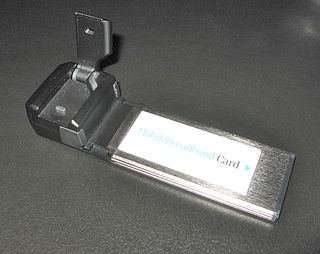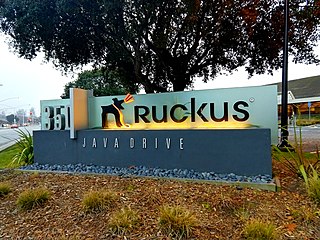Related Research Articles

IEEE 802.11 is part of the IEEE 802 set of local area network (LAN) technical standards, and specifies the set of media access control (MAC) and physical layer (PHY) protocols for implementing wireless local area network (WLAN) computer communication. The standard and amendments provide the basis for wireless network products using the Wi-Fi brand and are the world's most widely used wireless computer networking standards. IEEE 802.11 is used in most home and office networks to allow laptops, printers, smartphones, and other devices to communicate with each other and access the Internet without connecting wires.

A wireless LAN (WLAN) is a wireless computer network that links two or more devices using wireless communication to form a local area network (LAN) within a limited area such as a home, school, computer laboratory, campus, or office building. This gives users the ability to move around within the area and remain connected to the network. Through a gateway, a WLAN can also provide a connection to the wider Internet.

Wi-Fi is a family of wireless network protocols, based on the IEEE 802.11 family of standards, which are commonly used for local area networking of devices and Internet access, allowing nearby digital devices to exchange data by radio waves. These are the most widely used computer networks in the world, used globally in home and small office networks to link desktop and laptop computers, tablet computers, smartphones, smart TVs, printers, and smart speakers together and to a wireless router to connect them to the Internet, and in wireless access points in public places like coffee shops, hotels, libraries and airports to provide the public Internet access for mobile devices.

3G is the third generation of wireless mobile telecommunications technology. It is the upgrade for 2.5G GPRS and 2.75G EDGE networks, for faster data transfer. This is based on a set of standards used for mobile devices and mobile telecommunications use services and networks that comply with the International Mobile Telecommunications-2000 (IMT-2000) specifications by the International Telecommunication Union. 3G finds application in wireless voice telephony, mobile Internet access, fixed wireless Internet access, video calls and mobile TV.

A wireless Internet service provider (WISP) is an Internet service provider with a network based on wireless networking. Technology may include commonplace Wi-Fi wireless mesh networking, or proprietary equipment designed to operate over open 900 MHz, 2.4 GHz, 4.9, 5, 24, and 60 GHz bands or licensed frequencies in the UHF band, LMDS, and other bands from 6 GHz to 80 GHz.

WiMAX is a family of wireless broadband communication standards based on the IEEE 802.16 set of standards, which provide multiple physical layer (PHY) and Media Access Control (MAC) options.
4G is the fourth generation of broadband cellular network technology, succeeding 3G, and preceding 5G. A 4G system must provide capabilities defined by ITU in IMT Advanced. Potential and current applications include amended mobile web access, IP telephony, gaming services, high-definition mobile TV, video conferencing, and 3D television.

IEEE 802.16 is a series of wireless broadband standards written by the Institute of Electrical and Electronics Engineers (IEEE). The IEEE Standards Board established a working group in 1999 to develop standards for broadband for wireless metropolitan area networks. The Workgroup is a unit of the IEEE 802 local area network and metropolitan area network standards committee.

Sprint Corporation was an American telecommunications company. Before it merged with T-Mobile US on April 1, 2020, it was the fourth-largest mobile network operator in the United States, serving 54.3 million customers as of June 30, 2019. The company also offered wireless voice, messaging, and broadband services through its various subsidiaries under the Boost Mobile and Open Mobile brands and wholesale access to its wireless networks to mobile virtual network operators.
IEEE 802.11n-2009 or 802.11n is a wireless-networking standard that uses multiple antennas to increase data rates. The Wi-Fi Alliance has also retroactively labelled the technology for the standard as Wi-Fi 4. It standardized support for multiple-input multiple-output, frame aggregation, and security improvements, among other features, and can be used in the 2.4 GHz or 5 GHz frequency bands.

Siavash Alamouti is a business executive. He is the EVP of Innovation R&D at Wells Fargo and the executive chairman of Mimik technology. Prior to that, Siavash Alamouti was the President and CEO of the edge cloud software company mimik.

Mobile broadband is the marketing term for wireless Internet access via mobile networks. Access to the network can be made through a portable modem, USB wireless modem, or a tablet/smartphone or other mobile device. The first wireless Internet access became available in 1991 as part of the second generation (2G) of mobile phone technology. Higher speeds became available in 2001 and 2006 as part of the third (3G) and fourth (4G) generations. In 2011, 90% of the world's population lived in areas with 2G coverage, while 45% lived in areas with 2G and 3G coverage. Mobile broadband uses the spectrum of 225 MHz to 3700 MHz.
WiTricity is an American wireless charging technology company based in Watertown, Massachusetts. The Massachusetts Institute of Technology (MIT) spin-off was founded by professor Marin Soljačić in 2007. WiTricity technology allows wireless power transfer over distance via magnetic resonance and the company licenses technology and reference designs for wireless electrical vehicle (EV) charging as well as consumer products such as laptops, mobile phones and televisions.

The Wireless Gigabit Alliance was a trade association that developed and promoted the adoption of multi-gigabit per second speed wireless communications technology "WiGig" operating over the unlicensed 60 GHz frequency band. The alliance was subsumed by the Wi-Fi Alliance in March 2013.
WiGig, alternatively known as 60 GHz Wi-Fi, refers to a set of 60 GHz wireless network protocols. It includes the current IEEE 802.11ad standard and also the upcoming IEEE 802.11ay standard.

Ruckus Networks is a brand of wired and wireless networking equipment and software owned by CommScope. Ruckus offers Switches, Wi-Fi access points, CBRS access points, Controllers, Management systems, Cloud management, AAA/BYOD software, AI and ML analytics software, location software and IoT controller software products to mobile carriers, broadband service providers, and corporate enterprises. As a company, Ruckus invented and has patented wireless voice, video, and data technology, such as adaptive antenna arrays that extend signal range, increase data rates, and avoid interference, providing distribution of delay-sensitive content over standard 802.11 Wi-Fi.

The Next Generation Mobile Networks (NGMN) Alliance is a mobile telecommunications association of mobile operators, vendors, manufacturers and research institutes. It was founded by major mobile operators in 2006 as an open forum to evaluate candidate technologies to develop a common view of solutions for the next evolution of wireless networks. Its objective is to ensure the successful commercial launch of future mobile broadband networks through a roadmap for technology and friendly user trials. Its office is in Frankfurt, Germany.
Fujitsu Ltd. v. Netgear Inc., 620 F.3d 1321, was a patent infringement case centered on three patents claimed to be required for full compliance of the IEEE 802.11 (WiFi) standard and the WiFi Alliance Wireless Multimedia Extensions (WMM) Specification. US patents 4,975,952, 6,018,642, and 6,469,993 were owned by Philips Electronics, Fujitsu, and LG Electronics respectively, and placed in the Via Licensing pool. The Via Licensing pool claimed to hold all patents required for a complete WiFi/WMM implementation. Netgear did not enter an agreement with Via Licensing but produced a series of products that conform to the WiFi standard and WMM Specification. Philips Electronics, Fujitsu, and LG Electronics sued Netgear for patent infringement claiming a complete implementation of the WiFi standard implied violating patents held by Via Licensing pool. When tried in United States District Court for the Western District of Wisconsin, the court granted summary judgment of non-infringement by Netgear for all three patents thus plaintiffs appealed. The United States Court of Appeals for the Federal Circuit confirmed non-infringement for two of the three patent and found infringement of the third patent in four of Netgear's products.
WiLAN is a technology development and intellectual property licensing company with headquarters in Ottawa, Ontario, Canada. WiLan licenses patent portfolios that it owns and also partners with owners of patent portfolios. WiLAN Labs conducts ongoing research and development into advanced wireless communication systems. WiLAN is the main subsidiary of Quarterhill Inc., which is listed on the Toronto Stock Exchange.
The Wireless Broadband Alliance (WBA) is a global organization that connects people with the latest Wi-Fi initiatives. Founded in 2003, the vision of the WBA is to drive seamless, interoperable service experiences via Wi-Fi within the global wireless ecosystem.